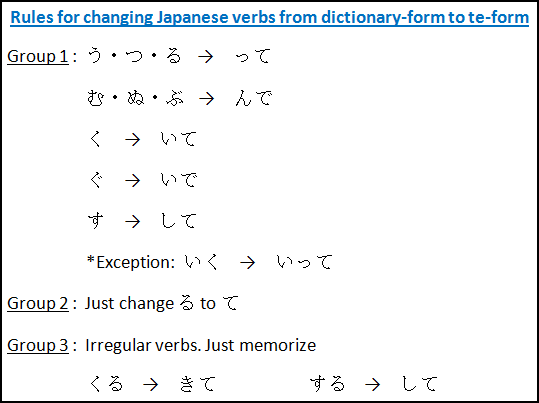- Home
- Basic Lessons
- Japanese Verbs te-form
Making Japanese Verbs te-form -
Free Japanese Lessons: 21
As you will see, て-form (te-form) of Japanese verbs has many functions. You can use it to form different verb sentences.
One basic function of te-form is to connect verb sentences.
When two or more actions take place in succession, the actions are mentioned in the order of occurrence by using the te-form. It looks similar to the function of the English word "then".
There is no past tense for te-form. The tense of the sentence is determined by the tense form of the last verb in the sentence.
Therefore for those actions taken before the last verb, they are always represented by te-form. For example,
- あさパンをたべて、コーヒーをのんで、がっこうへいきます。
asa pan wo tabete, ko-hi- wo nonde, gakkou e ikimasu
Meaning: In the morning, I eat bread, drink coffee and go to the school.
- としょかんへいって、ほんをかりて、うちへかえりました。
toshokan e itte, hon wo karite, uchi e kaerimashita
Meaning: I went to the library, borrowed a book and went back home.
How to Make Japanese Verbs て-form (te-form)?
Let's see how to make te-form from dictionary-form.
Group 1 Verbs
For group 1 verbs which end up with the words う (u), つ (tsu) or る (ru), replace these words with って (tte). For those verbs which end up with the words む (mu), ぬ (nu) or ぶ (bu), replace the words with んで (nde).
For group 1 verbs which end up with the word く (ku), change the word to いて (ite). For those which end up with the word ぐ (gu), change it to いで (ide). And for those which end up with the word す (su), change it to して (shite).
However, there is one exception. (In Japanese you always come across many exceptions). For the japanese verb いく (iku) which means "to go", the te-form is いって (itte).
Group 2 Verbs
Group 2 verbs always end with the word る (ru), you just need to replace る (ru) with て (te).
Group 3 Verbs
For group 3 verbs, the te-form of する (suru) is して (shite) and the te-form of くる (kuru) is きて (kite).
The following diagram shows the summary of how to change from dictionary-form to te-form for Japanese verbs.

Examples of Changing Japanese Verbs to te-form
Let's see some examples of changing Japanese verbs from dictionary-form to te-form.
Group 1 Verbs
| dict-form | Meaning | te-form | |
| 1. | ある | Exist (Thing) | あって |
| 2. | かかる | Hang/Take | かかって |
| 3. | よむ | Read | よんで |
| 4. | のむ | Drink | のんで |
| 5. | きく | Listen/Ask | きいて |
| 6. | みがく | Brush | みがいて |
| 7. | あらう | Wash | あらって |
| 8. | かう | Buy | かって |
| 9. | いく | Go | いって (Exception) |
| 10. | かえる | Go Back | かえって (Not Grp 2) |
| 11. | はいる | Enter | はいって (Not Grp 2) |
| 12. | はしる | Run | はしって (Not Grp 2) |
| 13. | のる | Get On/Ride | のって |
| 14. | わかる | Understand | わかって |
| 15. | おくる | Send | おくって |
| 16. | およぐ | Swim | およいで |
| 17. | あそぶ | Play | あそんで |
| 18. | かく | Write | かいて |
| 19. | だす | Take Out/Submit | だして |
| 20. | とる | Take/Pick Up | とって |
| 21. | ひく | Pull/Play (Piano) | ひいて |
| 22. | おろす | Lower/Get Down | おろして |
| 23. | はなす | Speak/Talk | はなして |
| 24. | まつ | Wait | まって |
| 25. | はじまる | Begin/Start | はじまって |
| 26. | おわる | End/Finish | おわって |
| 27. | おもう | Think/Feel | おもって |
| 28. | もらう | Receive/Get | もらって |
Group 2 Verbs
| dict-form | Meaning | te-form | |
| 1. | いる | Exist (Human/Animal) | いて |
| 2. | たべる | Eat | たべて |
| 3. | みる | See | みて |
| 4. | あびる | Bathe/Shower | あびて |
| 5. | でる | Appear/Leave | でて |
| 6. | おりる | Alight/Get Off | おりて |
| 7. | みえる | Be Seen/Seem/Appear | みえて |
| 8. | きこえる | Be Heard/Said to be | きこえて |
| 9. | むかえる | Welcome/Greet | むかえて |
| 10. | ねる | Go to Bed | ねて |
| 11. | おきる | Wake Up/Rise/Happen | おきて |
| 12. | あげる | Give/Offer/Raise | あげて |
| 13. | くれる | Be Given/Let One Have | くれて |
Group 3 Verbs
| dict-form | Meaning | te-form | |
| 1. | くる | Come/Arrive | きて |
| 2. | する | Do/Execute/Play | して |
| 3. | べんきょうする | Study | べんきょうして |
| 4. | さんぽする | Walk/Stroll | さんぽして |
You can use te-form of Japanese verbs to make long sentences. For example, you can make one long sentence if you want to say all the things you are doing everyday...
- あさおきて、はをみがいて、ごはんをたべて、シャワーをあびて、せいふくをきて、しんぶんをよんで、がっこうへいって、。。。て、。。。て。。。
asa okite, ha wo migaite, gohan wo tabete, shawa- wo abite, seifuku wo kite, shinbun wo yonde, gakkou e itte, ...te, ...te, ...
Meaning: I wake up in the morning, brush my teeth, eat cooked rice, take a shower, wear my uniform, read newspaper, go to school, ..., ..., ...
You can make a sentence using te-form just like the above example. It is also fine to make a sentence with only two actions with te-from, as long as the order of occurrence is followed as mentioned in the sentence.
Related Pages
Lesson 18: Verbs.
Lesson 19: Verbs Part 2 - Change dictionary-form to masu-form and nai-form.
Lesson 20: Verbs on give and receive.
Lesson 22: Verbs on Progress Action, Habitual Action & Occupation.
Lesson 23: Verbs of Motion & How to Make Request in Japanese.
Lesson 29: Verbs on State Continuation.
Lesson 30: Verbs - Transitive and Intransitive verbs.
Lesson 31: Verbs on State Continuation Transitive/Intransitive.
Best Deal of the Year! Get 68% OFF Lifetime Premium! Ends on 13 Dec 2025
Click Here to Get 68% OFF Lifetime Premium and be on the fast track to fluency in Japanese.
The link above is an affiliate link, which means that I would earn a commission (at no extra cost to you) if you do end up purchasing the related learning course.
Previous - Lesson 20: Verbs Give Receive
Buy me a coffee









Facebook Comments
Don’t see the comments box? Log in to your Facebook account, give Facebook consent, then return to this page and refresh it.